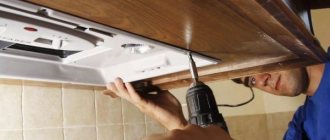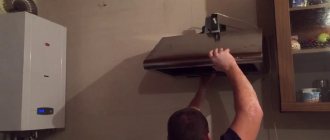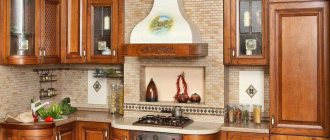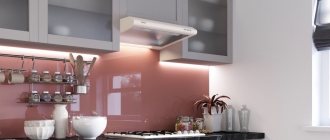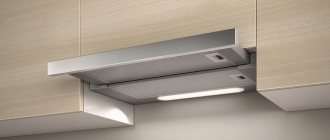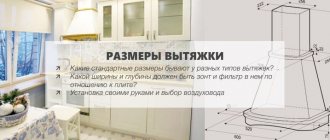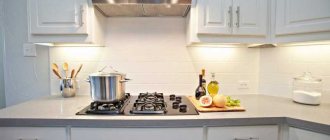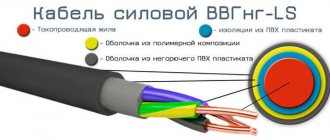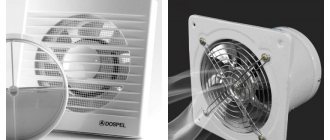According to the principle of operation, all exhaust systems resemble a vacuum cleaner, but they face completely different tasks. The hood is designed to remove various particles that appear in the air during cooking, thereby extending the life of furniture and other accessories. How is this function implemented? Let's look at the hood design and its main components.
Why do you need a hood in the kitchen?
If, when cooking, all the “kitchen” smells can be clearly felt even in the farthest corners of your home, then it’s time to think about organizing high-quality exhaust ventilation. An efficient working hood is also required for apartments with gas stoves: this is one of the basic safety rules when operating gas-powered kitchen appliances.
In addition to unpleasant odors and the accumulation of unburned gas residues, there are two more reasons to take care of effective ventilation and improve air exchange in your home:
- Burning of food . Pyrolysis of “organic matter” when food products burn leads to the formation of volatile harmful substances. Kitchen fumes (oils and fats released into the air during cooking) then settle on furniture, wall coverings and dishes;
- High humidity. Excess moisture that forms during heat treatment of foods then condenses on all exposed surfaces. With regular cooking, this provokes the formation of mold on the walls and ceiling. A well-functioning hood ensures removal of air containing excess moisture, maintaining a comfortable microclimate in the house.
Air removal system parameters
To determine the most important dimensions of pipes and air intakes, you will need to perform a small calculation in the following order:
- We determine the amount of air flowing through the kitchen ventilation per unit of time;
- Knowing the cubic capacity of the kitchen air space and the recommended air speed values, we calculate the cross-sectional area and the recommended diameter of the air duct.
This is enough to build simple ventilation in the kitchen. As a rule, a kitchen ventilation system is assembled from two independent subsystems - natural and supply and exhaust. Both schemes are calculated based on the maximum air exchange rate in the isolated kitchen space. For a private home, according to SanPiN 2.1.2.2645-10, the air in the kitchen atmosphere should change from 3.5 to 5 times per hour, depending on the type of stoves and ovens used.
If the kitchen is planned in the form of one large studio or pavilion, or a semi-open veranda, the gas exchange rate can be reduced to 2.5-3 times.
Why does the hood stop working?
This happens for several reasons:
- The decorative grill covering the channel opening is dirty . This is the simplest option - you can solve the problem on the spot by removing the grille and cleaning it of soot and dust;
- Clogged ventilation duct . The air duct may become clogged with debris and accumulated dust. In winter, an ice build-up may form in it, preventing the outflow of air. Cleaning of the ventilation duct should be carried out by specialists of the management company;
- Dismantling of part of the air main by one or more residents. As a rule, the goal of apartment owners in this case is to increase living space. Such actions are illegal. In such a situation, it is necessary to draw up a collective complaint to the supervisory authorities.
Main components
Installing any class of hood in your kitchen is quite simple. In flow-through models, the lower part acts as a grease trap or coarse filter, the task of which is to retain fat particles and soot.
Modern models “hide” it behind a decorative cover.
Inside the air intake are fans driven by motors specially designed for hood use. With a direct-flow system, behind the fans there is an air duct connected to the building's ventilation system.
Coarse filter
In recirculating hoods, fine carbon filters are installed after the fan, the task of which is to remove unpleasant odors, because the air flow returns to the kitchen area. Coarse filters are made of durable aluminum and can be washed like greasy dishes. They are very light and not subject to corrosion. Carbon filters are inserted using a special cassette; they are very thin; they must be changed according to the recommendations in the instructions for each hood.
Nuances of ventilation in apartment buildings
Before you start upgrading your kitchen hood, you need to understand the main principle of operation of the air exchange system in standard high-rise buildings. It is simple: a ventilation duct in each of the apartments ensures that exhaust air is drawn into a common ventilation shaft and then discharged outside.
There is one caveat - in order for the “old” air to be drawn out of the apartment, fresh air must constantly flow into it. This air exchange system was designed for wooden windows: even when closed, they let in air in the required quantities. If you remember, it was for this reason that the windows were insulated and sealed in winter, because... non-sealed frames began to actively let in cold air.
Nowadays, wooden windows have become an anachronism - they are everywhere being replaced with plastic ones. Being closed, they do not let anything through - no noise, no dirt, no... air. Thus, air exchange in the apartment stops.
This results in increased humidity, mustiness, a persistent cooking smell, low oxygen levels and increased carbon dioxide.
Exhaust fan
An important component for hoods is a fan, which draws polluted air out of the room. Diametrical or tangential fans have proven themselves well in exhaust systems - they hold the maximum load well.
The fan impeller looks like a hollow cylinder made of slightly forward-curved blades, which creates a uniform air flow. This type of product has a high efficiency = 0.7, high air flow, which is easily directed in any convenient direction, and a low noise level. They also create a fairly low pressure in the system.
How to complement the hood in the kitchen?
Option one - forced exhaust system.
May have different designs:
- wall-mounted hood with built-in fan, which is installed directly above the stove;
- suspended ceiling hiding a forced air duct;
- installation of a duct exhaust fan in a passive exhaust air duct.
Despite the fact that the forced exhaust system copes with its task better than the passive one, it still has its drawbacks:
- decreased efficiency in cold weather;
- the need to control the moments of turning the unit on and off;
- increase in electricity costs;
- during intensive cooking (using several burners), the exhaust ventilation will not be able to remove cooking odors and excess moisture.
But its main drawback is different. After installing such a system, the problem of lack of fresh air will not be solved.
Option two is to install fresh air ventilation.
The two most common options for such a solution are a valve and an air supply unit.
Valve . This design is installed in a through channel, which is drilled into the wall facing the street. Air intake from the street occurs naturally, due to the difference in pressure inside and outside the apartment or room. This option is suitable for both apartments and private houses. The valve is suitable for small areas with a minimum number of residents (1-2 people).
The peculiarity of this solution is:
- ease of installation;
- low cost of the device;
- efficiency (the device works without electricity).
Household supply ventilation unit TION . It is a device equipped with a fan, filter and electronic control unit. Provides a constant flow of fresh air from the street, thereby “launching” the process of active air exchange in the room. The inflow intensity is adjustable. Breezers Tion 02 and Tion 3S are also equipped with a heater.
The combination of “TION + passive exhaust” is the optimal solution. They complement each other perfectly:
The supply unit takes in clean, fresh air, and exhaust air leaves through the hood. In this case, the air flow circulates without interruption and with the windows closed.
Electrical components
Any kitchen hood always consists of at least two branches:
- Lighting where it is not customary to use LEDs, since the resulting circuit is very complex and flicker appears, which is harmful to the human body. A simple incandescent lamp or energy-saving elements are used everywhere.
- The second main element is the engine, which has a number of protective elements. These are fuses and capacitors to suppress sparking in commutator type motors. To protect against spark breakdown, varistors are installed, whose resistance changes during voltage surges. This spare part is always installed in pairs. When a spark strikes, the voltage goes to the hood body and goes around the entire system, protecting the home electrical network from overload and the motor winding from burnout.
You can install a commutator motor on a kitchen hood that is not afraid of overheating, but manufacturers additionally supply them with thermal fuses. Because of this, the noise impact will be higher than normal: for a hood, this indicator directly depends on the type of electric motor installed. Therefore, an asynchronous motor with a rotor like a squirrel wheel will function cheaper and better.
A few more words about lighting - many users do not pay due attention to it, but in vain. It is better to use halogen lamps, they are energy-saving, are not afraid of frequent switching on or off, and provide diffused light that does not tire the eyes.
How is the supply ventilation unit installed and connected?
The first stage is determining the installation location. The breather can be installed at any point on the wall (the main thing is that it faces the street). Most often, the device is mounted on the side of the window or under the windowsill. The choice of location is simplified by the compact dimensions of the internal unit (Tion Breezer Lite has only 26*26*13 cm) - this is less than a standard sheet of A4 paper.
The second stage is drilling a through channel in the wall. For this purpose, a modern diamond drilling installation is used, which allows even complete repair work to be completed - quickly, without dirt and dust.
After the channel is ready, it is thermally insulated and soundproofed using special materials. A protective grill is installed on the street side to prevent insects and debris from entering the channel. Then the device is fixed on the wall and connected to the air duct. Connection to the electrical network is made using a regular outlet.
Types of fastenings
According to the installation method, a homemade kitchen hood is divided into 4 types:
- Wall-mounted. Attach to the wall above the stove.
- Corner. Installed in the corner of the kitchen.
- Built-in. They are built into a wall cabinet above the hob or into a table located near it, and the product is also installed in a decorative fireplace dome.
- Ostrovnaya. Attached to the ceiling.
When attaching the product, take into account the following: the distance between the equipment and the electric stove must be at least 70 cm, gas - 80 cm.
Let's summarize.
If you are wondering what needs to be done to ensure that the hood in the kitchen works well and performs its functions, then installing an air supply system will be the best answer.
In this case, you will have a choice - to design and install ventilation yourself, or contact a specialized company. It must be said that in the first case, solving the problem requires time, professional skills and the availability of special equipment. You assume all risks.
When you contact the company, the question of how to properly install ventilation will disappear by itself. The installation of the breather is carried out by certified specialists, with a guarantee of quality of work. The warranty on the device and installation is 2 years.
Electrical installation features
Wiring for the installed equipment is planned and laid in advance.
Depending on the method of connecting the hood to the electrical network and the comprehensive design of the kitchen, the solution to the issue may be as follows:
- The standard electric cord for range hoods is quite short. Therefore, when connecting a plug to a socket, the latter must be provided and installed in advance. Wiring or an extension cord with a socket can be carefully laid behind furniture or covered with a PVC box.
- The connection via a machine (permanent) is made in a phase break.
- Grounding is always connected first.
The second and third points are mandatory.
Type of control, ease of use comes down to the little things
There are several types of device control that can be selected based on cost and comfortable use of the hood:
- remote;
- button;
- sensory.
The first type is a better decision made by manufacturers. Its remote control will be more expensive than other control analogues, but the convenience is worth it.
The push-button option is a classic option; it is used for most hoods. In addition, their price is reasonable, which is a tangible benefit for many buyers.
The touch screen is operated by lightly touching the outer surface with your fingers. Very convenient to use, belongs to the middle price segment.
Manufacturers often integrate an additional set of functions into devices, which makes handling the device much more comfortable.
Here are just a few of them:
- Backlight. It is installed on most models. LED, halogen or incandescent lamps are used.
- Emergency mode. Hoods with smoke protection are available. They turn on individually when the sensor detects smoke or excessive evaporation. As soon as the unpleasant phenomena disappear, the device automatically turns off, which saves electricity.
- Timer. Convenient function when operating an exhaust device. It can be set to turn off the hood after cooking, for example after 15 minutes. During this time, the device will remove all odors and turn itself off.
- Design. It is necessary to highlight the style elements that manufacturers provide modern products with. These include: elegant lighting, unusual configurations, all kinds of displays and other delights.
Device models offered by manufacturers
Time-tested and proven quality equipment from German, Swedish or Japanese manufacturers is considered the most reliable. But recently, domestic companies have also been producing decent models of hoods.
Bosch DFS 067K50
The manufacturer, whose quality of household appliances has remained at the highest level for many years, offers various types of hoods: wall-mounted, built-in and telescopic.
Bosch DFS 067K50
Model DFS 067K50 is suitable for installation in suspended modules; it is equipped with touch controls, a retractable screen and backlighting with variable light levels. The automatic selection of operating mode and indication of the filter status are very convenient. The only significant drawback of the product is its high price.
Shindo Avior Sensor 60 SS/BG 3E
The products of the Japanese company are characterized by ergonomics and functionality. The hoods are maximally equipped with electronic components, which increases convenience for the consumer.
Shindo Avior Sensor 60 SS/BG 3E
The dome model Avior Sensor 60 SS/BG 3E (made in China), with a glass visor, is made in the Art Nouveau style. A high-performance product that operates in various modes (circulation and air removal), is equipped with LED lamps and sensors that allow the device to automatically regulate the intensity of work.
Inclined hood Shindo AVIOR sensor
Siemens LC68BA572
The German concern, whose products do not require additional recommendations, offers the consumer a wide range of different types of hoods. Fans of technology with the maximum number of bells and whistles are even offered models with built-in TVs.
Siemens LC68BA572
The dome-type hood LC68BA572 is suitable for installation in spacious kitchens. It effectively purifies the air to the required level.
Extremely quiet thanks to additional sound insulation
Various types of sensors themselves determine when the device should operate. The body of the device is easy to clean, and the installed LEDs allow you to cook in the dark. But not everyone will like the price of this product.
Kitchen hood 60 cm Siemens
Kronasteel Kamilla Sensor 600
The German manufacturer, which opened a representative office in the Russian Federation, produces equipment of decent quality. The range of hoods includes models that differ in configuration and characteristics, but all of them are effective and easy to use.
Built-in hood Kamilla Sensor 60
The built-in hood Kamilla Sensor 600 can operate in exhaust and circulation mode, is equipped with two 100 W motors, a touch panel and halogen backlight. The model looks very attractive and works quietly, has 3 operating speeds, a timer and an anti-return valve.
"Elikor Integra 60"
We can safely say that recently this Russian company has begun to provide worthy competition to Western manufacturers. Household and professional hoods have an excellent price/quality ratio.
"Elikor Integra 60"
It is possible to choose a device that operates using a flow or circulation cleaning method. Budget products are equipped with various options that help Elicor products meet the needs of modern consumers. The highlight of the brand is the collection of models decorated with paintings.
Kitchen hood Elikor
The Integra 60 model is perfect for installation in small kitchens. The device is reliable; it can be connected to an air duct or operated in circulation mode.
Mesh removal handle
A fairly simple product with mechanical control and two speed modes has one obvious drawback - a high noise level during operation.
Kitchen hood Elikor in the interior
For clarity, a comparison of the cost and main characteristics of popular models is offered.
| Model | Productivity, m3/h | Width, mm | Power, W |
"Integra 60" | 400 | 600 | 200 |
Kamilla Sensor 600 | 550 | 600 | 2 x 100 |
DFS 067K50 | 700 | 600 | 146 |
LC68BA572 | 760 | 600 | 166 |
Avior Sensor 60 SS/BG 3E | 800 | 600 | 238 |
Having carefully studied the models offered by manufacturers and settled on a device that suits you best in terms of functionality, price and external characteristics, you can purchase a hood that is optimally suited for a particular kitchen.
Classification by type of cleaning
In accordance with the features of the air purification method, all hoods are conventionally divided into two main categories. There are recirculation complexes: they conduct air coming from the kitchen through special filter elements and direct it back. In fact, they are not exhaust systems, since the air coming from the room is not removed, but is subjected to basic cleaning using the appropriate elements of the device.
Hoods of the second type are flow-through, due to which polluted air enters the home ventilation system, and from there it is discharged outside, providing effective ventilation in the kitchen. Such systems include a special pipe - it can be made in the form of a corrugated or metal channel with a round or tetrahedral cross-section. Through it, the device is connected to the ventilation system.
Important! As for the dimensions, devices of the first category are relatively more compact, and their connection is much easier.
Today, combined models of exhaust systems are also available for sale: they combine both types of devices in their operation, the user can switch between them at his own discretion.
Some practical tips
If you have no financial restrictions, opt for a kitchen hood that can function in two ways - to divert the air flow outside the room and in automatic recirculation mode.
About the engine. To avoid negative effects on the hearing organs, it is recommended to use two low-power motors instead of one high-performance motor. We also offer the most silent models of exhaust systems with a noise level not exceeding 40 dB.
There are a huge number of models in special retail outlets, and sometimes it can be quite difficult to decide and understand how to properly make a kitchen hood. Taking into account the recommendations set out in the material, you can make the right choice in favor of a reliable home assistant that can make daily culinary work easier and make it safer for the health of all family members.
Recommendations from the experts
Before you start creating the ventilation system in question, you need to double-check all the calculations made several times in order to avoid making a mistake, which can then be costly. Experts also advise using only proven components from well-known manufacturers. Otherwise, there is a risk that a fan may fail, which will disrupt the entire operation of the ventilation system.
If you cannot perform any procedure with your own hands, you should not hesitate to contact a specialist. It is better to spend a little time and money on consulting a professional than to make a mistake on your own that could disrupt the operation of the entire system.

